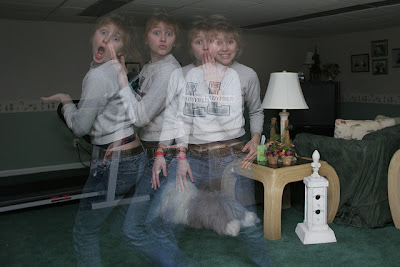Stroboscopic flash photography is the technique used by photographers to capture a sequence of images of a moving subject in a single frame. The trick behind stroboscopic flash effect is to fire a rapid burst of low power flashes during the course of a photographic exposure. With each pulse of flash an instance of the subject at its then state is captured and thus at the end of the exposure the frame will have various instances of the subject. The number of instances captured will depend on the number of flashes fired during the exposure.
 |
| Photo By Patrickkwk |
The Three major elements of Stroboscopic Flash Photography
- Hertz (Hz)
- Flash count
- Flash power
Hertz (Hz) denotes the frequency at which the flash is fired. Hertz is measured in seconds 1Hz = once a second and 5Hz = five times a second so higher the value, the more is the number of flashes happening per second. When in stroboscopic mode the flash allows you to set the frequency, generally modern flash guns allows values between 1 – 199 Hz.
 |
| Photo By ?UG? |
Flash count is the total number of pulses emitted by the flash during the exposure. Only the latest flash units allows you to set this manually, in earlier models you just set the frequency and shutter speed and do the Flash Count calculation manually
 |
| Photo By AveLardo |
Flash count = Shutter Speed * Hertz (Hz)
For example if the shutter speed set is 2 seconds and the frequency (Hertz (Hz)) set is 5 then flash count will be 2 * 5 = 10
In latest flash units you set the frequency fist (Hertz (Hz)), then set the number of pulses (Flash Count) and based on it calculate the required shutter speed using the following equation.
Shutter speed = Flash count / Hertz (Hz)
For example to calculate shutter speed when the flash count set is 10 and the frequency (Hertz (Hz) set is 5, then the shutter speed should be a minimum of 10/5 = 2 seconds to allow all the pulses to fall within the exposure time.
Flash power is not determined by the flashes brightness but by the duration for which it’s emitting light. So when you change your flash setting to 1/4 power from 1/8 power you are actually doubling the flash duration and not doubling the flashes brightness.
 |
| Photo By Aaron Geller |
Most flash units only allow a maximum power setting of ¼ th power or less when in stroboscopic mode.
All the three elements mentioned above are interlinked and changes to each affect the exposure of the image. When the frequency of flash (Hertz (Hz) is increased the flash has only less time per each pulse so the power of the flash will decrease and when the frequency is decreased the flash need to fire only fewer bursts and so greater will be its power.
Flash recycling time is also an important aspect, the faster the flash frequency the lesser the recycling time and so lesser the flash power and vice versa.
In order to cope with the decrease in power you will have to decrease the flash to subject distance considerably to correctly expose the picture. Remember the earlier article on Inverse Square Law of Light.
How to use Stroboscopic Flash
 |
| Photo By Aaron Geller |
- Set your camera on a tripod and switch it to Manual mode
- Attach flash and set it to stroboscopic mode
- Set the Flash count
- Set the Frequency (Hertz (Hz)
- Calculate and set the shutter speed required (Shutter speed = Flash count / Hertz (Hz)
- Focus on the subject and shift focus to manual to keep it locked
- Use the table in the instruction manual or use trial and error to find the right Aperture value
- Press shutter, check the image in LCD and make corrections to aperture or flash power values if necessary.
 |
| Photo By Dave F |
Stroboscopic effect is best achieved when done on a bright subject in a dark background. If the background is not black the light from multiple pulses will be added together to expose quite a bit of details in the background and will create many issues. Shooting at night out in a dark open ground is the best and easiest way to experiment stroboscopic effect as you need not worry about the flash illuminating anything in the background. All you need to focus will be on the flash power and subject to flash distance.
 |
| Photo By Robbie Veldwijk |
While experimenting with stroboscopic flash photography effect; it should always be kept in mind that firing multiple flashes consecutively is a strain on your flash units and as a result it may heat up and cause damage to the flash. So never attempt more than 10 trials before giving the flash a little time to cool off. Or better work at a slow pace allowing time in between each trial.
In the next article we will discuss about Photography - Lighting - Flash - Understanding TTL Flash – 5 Tips For Using Your Flash Creatively
Related Reading
- Understanding TTL Flash – Flash Terminology, Anatomy, Functions and Features
- Fill Flash
- Slow Sync Flash
- How to Trigger your Off Camera Flash
- Focal Plane Shutter
Post a Comment